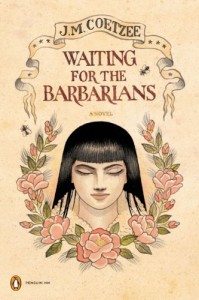Coetzee, J.M. (1980). Waiting for the Barbarians. New York: Penguin.
This short novel (180 pages) is the first-person account of an unnamed, aging magistrate, administrator of a military fort on a remote frontier of “The Empire.” No exact time and place are specified so the story can stand as a universal parable. Some readers assume, because of Coetzee’s heritage, that the tale is “about” the injustices of the apartheid regime in South Africa. That may have been a source for him, but it is a myopic reading to assume the novel is about South Africa. The time, based on technology mentioned could be anywhere from the 1800’s to the rural 1950’s. Transportation is by horse and wooden carts, communication is by voice and flags, but there are rifles. The place could be any country in the world that has a central government with an army, and a wild frontier.
There are nomads and fishing groups camped outside the walls of the town, but farther out are the feared “barbarians.” The townspeople lose the occasional sheep to a barbarian raid, but in general there is a stable status quo. Then a contingent of soldiers from “The Empire,” arrives to subdue the barbarians. The soldiers round up several of them, bring them to the town and torture them brutally. The magistrate takes note, argues there is no need for it, but otherwise watches, squeamishly, without intervention. “The jackal rips out the hare’s bowels but the world rolls on,” he remarks (p. 25).
When the army goes afield again to get more barbarians, the magistrate discovers a young barbarian beggar in town. Her father was killed in front of her eyes, she has been tortured herself, and is now blind and hobbled. He ministers to her in his quarters. Why he does this is not clear, either to the reader, or to himself.
Over time, he develops a relationship with the girl which develops into bodily intimacy, but not sexual intercourse. He claims he is too old for that, but he is conflicted and confused about sexuality, his own, and what sex means in general. We can surmise he might be subconsciously trying to atone for the cruelty of the soldiers, but his motivation seems more complex. The girl acquiesces, but is unresponsive. That lack of response drives him nuts and he wonders if it is a characteristic of being a barbarian.
Parallel themes emerge. One is, what is a barbarian? Or its converse, what does it mean to be civilized? That puzzle continues for the rest of the book. The second central theme is, what is the nature of human sexuality, specifically, what is sexual desire? This theme also continues for the rest of the book.
A third theme also emerges, the most obvious one: What is a person’s moral responsibility when they realize that they are a member of a cruel, unjust, authoritarian regime? Does one go along, or stand against? The theme emerges when the magistrate is arrested for consorting with the enemy, imprisoned, and tortured.
While the dilemma of the magistrate’s moral stance on torture is raised, the more cogent question is what constitutes civilization? Is torture not barbarism? The magistrate never forms that question explicitly but the reader certainly does.
None of these questions is resolved for the magistrate. The novel ends with him as confused as he was in the beginning. That is a disappointment, for we are deprived of an opportunity to consider Coetzee’s answers to the questions he has so skillfully and memorably raised. Is it enough in an artistic project to raise deep questions about the human condition, or should the artist at least attempt some answers?

